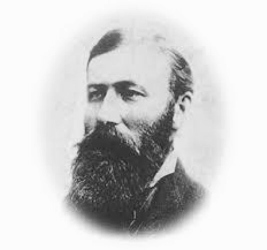Gustave Niebaum facts for kids
Quick facts for kids
Gustave Ferdinand Niebaum
|
|
|---|---|
 |
|
| Born |
Gustaf Ferdinand Nybom
August 31, 1842 |
| Died | August 5, 1908 (aged 65) |
| Occupation | Sea Captain Winemaker |
| Known for | One of the original commercial winemakers in the Napa County |
Gustave Ferdinand Niebaum was a brave sea captain and a famous winemaker. He was born Gustaf Ferdinand Nybom in Finland on August 31, 1842. He later became an American citizen.
Niebaum studied to become a sea captain in Helsinki, Finland. By the late 1860s, he was a top fur trader. He started the Alaskan Commercial Company in San Francisco, California. He also drew some of the first official maps of Alaska's coast. In 1867, he helped explore Alaska. He also supported the Alaska Purchase, which made Alaska part of the United States. At that time, Finland was part of Russia, and Niebaum was Russia's Consul in the U.S.
Contents
Early Life and New Name
Gustaf Ferdinand Nybom was born in Helsinki, Finland. His family spoke Swedish. His father, a police officer, died when Gustaf was only four years old.
When he was 16, Gustaf first sailed to Alaska. He was on a ship owned by a Russian company. Back then, both Alaska and Finland were controlled by Russia. After this trip, he studied in Helsinki to become a Master Captain. Soon, he returned to Alaska as a helmsman. He quickly became a captain.
In October 1867, Alaska became part of America. Nybom started a new company with five friends called Hansen, Nybom & Co. They became very rich by trading seal skins from Alaska. They sold these skins in San Francisco and made California their new home.
After many years of trading, Gustaf Nybom changed his name. He chose the German name Gustave Niebaum. People think he did this to fit in with his business partners. Many of his partners were German and saw a chance to grow wine grapes in the rich Napa Valley. They had been planting grapes since the 1860s. In 1873, Gustave married a German-American woman. In 1879, Niebaum and his wife bought 450 acres of land. They then started making their own wine.
Starting a Winery
In 1879, Niebaum opened his own winery called Inglenook Winery. It was in Rutherford, a small town in the Napa Valley.
Captain Niebaum first wanted to build a great winery in France. But his wife, who was from California, did not want to travel across the ocean so much. She preferred Napa instead.
Many of Niebaum's friends and workers from his old company also started wineries. They built their own businesses in Napa County. Niebaum's employee, Hamden McIntyre, designed special wineries. These wineries used gravity to move the grapes and wine. This made the winemaking process easier.
Making Quality Wines
Inglenook was Niebaum's favorite project. He worked very hard to make excellent wines. He often traveled to Europe to learn about vineyards and winemaking. He visited countries like Germany, France, and Italy. He then brought many different kinds of European grapevines to California. He also followed very high standards for making wine. His personal library had 600 books about wine that he collected on his trips.
At first, Niebaum replaced low-quality grapes on his land. He bought better grapes like Sauvignon Blanc. Later, he brought grape cuttings from Europe. He planted many types, including Cabernet Sauvignon and Merlot. He also planted white wine grapes like White Riesling. He was very careful during winemaking. He made sure to remove all stems and leaves from the grapes. He was also the only winemaker in Napa at that time to bottle his wines at his own winery. Most other wineries shipped their wine in large containers.
Winning Awards
Because of his hard work, Inglenook wines became famous worldwide. They won gold medals at the World's Fair in Paris in 1889. Their high quality continued for many years. In 1919, at the Panama-Pacific International Exhibition in San Francisco, Inglenook wines won 19 gold medals. This was far more than any other California winery.
Niebaum passed away in 1908. But his wife hired skilled managers to keep the winery going. One of them was Carl Bundschu.
After a time called Prohibition, when alcohol was not allowed, the winery was passed on. In 1939, Niebaum's great-nephew, John Daniels, Jr., took over. He had been taught by Carl Bundschu. Sadly, in 1964, the winery was sold to large companies.
In 1975, famous movie director Francis Ford Coppola bought part of the winery. He used money from his movie The Godfather. Coppola released his first wine in 1977. In 1995, Coppola bought the rest of Niebaum's original land and the main winery building. In 2006, the winery was renamed Rubicon Estate Winery. Then, in 2011, Coppola bought the name Inglenook. This brought the winery, vineyards, and brand name back together.
In 2007, Gustave Niebaum was honored after his death. He was added to the Vintner's Hall of Fame by the Culinary Institute of America.
Awards and Recognition
- In 1889, Inglenook wines earned gold medals at the World's Fair in Paris. It was the most successful non-French winery there.
- In 1919, Inglenook wines won 19 gold medals at the Panama-Pacific International Exhibition in San Francisco.
- In 2007, Gustave Niebaum was added to the Vintner's Hall of Fame. This honor was given by the Culinary Institute of America.

